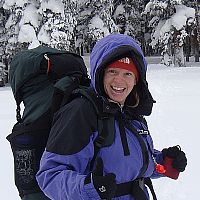John et al., 2010
Investigating the impact of temporal and spatial variation in spring snow melt on summer soil respiration.
John, G.P., Papuga, S.A., Wright, C.L., Nelson, K., Barron-Gafford, G.A. (2010)
AGU Fall Meeting (Poster) Abstract H33C-1154.
-
Catalina-Jemez, INVESTIGATOR
-
Catalina-Jemez, GRAD STUDENT
Abstract
While soil respiration - the flux of carbon dioxide from the soil surface to the atmosphere - is the second largest terrestrial carbon flux, it is the least well constrained component of the terrestrial carbon cycle. This is in part because of its high variability in space and time that can become amplified under certain environmental conditions. Under current climate change scenarios, both summer and winter precipitation are expected to be altered in terrestrial ecosystems of the southwestern US. Precipitation magnitude and intensity influence soil moisture, which is a key control on ecosystem-scale respiration rates. Therefore understanding how changes in snow and rainfall translate to changes in soil moisture is critical to understanding climate change impacts on soil respiration processes. Our study took place within the footprint of a semiarid mixed-conifer flux measurement system on Mount Bigelow just north of Tucson, AZ. We analyzed images from three understory phenology cameras (pheno-cams) to identify areas that represented early and late snowmelt. Within the field of view of each of the three pheno-cams we established three early-melt and three late-melt soil respiration measurement “sites”. To understand the persistence of snowmelt conditions on summer soil respiration, we measured soil respiration, soil moisture, and soil temperature at all six sites on four days representing different summer periods (i.e. pre-monsoon, early monsoon, mid-monsoon, and late monsoon). Throughout the entire study period, at both early- and late-melt sites soil respiration was strongly correlated with amount of soil moisture, and was less responsive to temperature. Soil respiration generally increased throughout the rainy season, peaking by mid-monsoon at both early- and late-melt sites. Interestingly, early-melt sites were wetter than late-melt sites following rainfall occurring in the pre- and early monsoon. However, following rainfall occurring in the mid- to late monsoon, late-melt sites were wetter than early-melt sites. These preliminary results are an important step toward understanding the role that temporal and spatial variations in snow cover, which will undoubtedly be impacted by climate change, play in the carbon dynamics of these semiarid mountain environments.
Citation
John, G.P., Papuga, S.A., Wright, C.L., Nelson, K., Barron-Gafford, G.A. (2010): Investigating the impact of temporal and spatial variation in spring snow melt on summer soil respiration . AGU Fall Meeting (Poster) Abstract H33C-1154..
Explore Further


